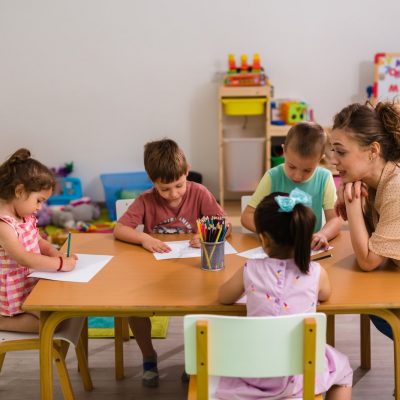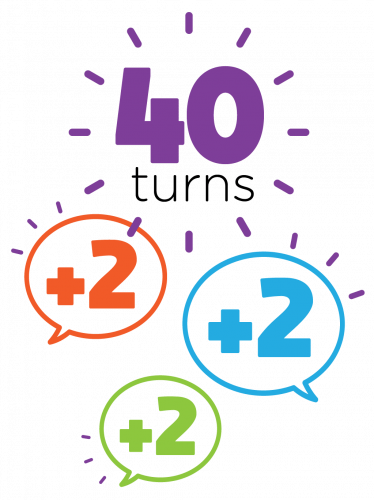Every Interaction Counts
Why Early Talk Matters
Adult-child interactions improve children’s futures.
Increasing adult-child interaction is one of the easiest and most cost-effective ways to improve outcomes. At LENA, we all these simple back-and-forth vocal exchanges conversational turns. Unfortunately, children experience much less adult-child interaction in child care centers than at home. That’s why it’s so important to understand the value of conversational turns and why early childhood education should focus on early talk.
Why focus on interactions?
A lot of research has linked interactive talk with optimal early childhood development in infants, toddlers, and preschooler — from language and emotional development to brain development and even IQ scores in middle school.
It’s so important for educators and caregivers to tune in and respond to children, even when their vocalizations are “just” babbles and grunts.
We also need policymakers to help childhood educators truly focus on responsive relationships with the children in their care.
Because, ultimately, a child’s school readiness is built on a foundation of trusting relationships — and that trust is only made possible through quality, frequent conversational turns. The amazing educators that teach young children, from 0 to 5 years, deserve supports that motivate, inspire, and provide actionable feedback on what matters most: building nurturing relationships that help children thrive.


How many conversational turns are best?
According to our Inside Early Talk Report: 40 conversational turns per hour is ideal.
Up to 40 conversational turns per hour, each increase of two turns per hour is linked to a one-point increase in Full Scale IQ.
Whether young children are in with their parents, other primary caregivers, center-based early educators, or family child care (FCC) early educators, they should ideally be experiencing at least 40 conversational turns per hour for healthy language, cognitive, and social development.

Home vs. early care settings
If 40 conversational turns per hour is the goal, then what’s the current reality? How many interactions do children experience in different early care settings? Our study comparing the experiences of over 24,000 children shows us that early care environments need big improvements.

Children in child care are less likely to experience optimal language environments.
At home, 29% of children experience at least 40 conversational turns per hour, compared to just 7% in center-based care*.
- Children at home are four times more likely to engage in 40 conversational turns per hour than children in child care centers.
- Children in FCC settings are twice as likely to engage in 40 conversational turns per hour as children in center-based care.
- Over 80% of children in home settings experience at least 15 conversational turns per hour, compared to just 50% of children in child care centers.

Average conversational turns by age
Infants in center-based care experience more interactions than older children. In home and FCC environments, children experience more conversational turns as they get older.
- Between 25 and 36 months of age, children in home settings experience an average of 40 conversational turns per hour, more than double what children in child care centers experience.
- Differences across settings are smallest for infants and greatest for toddlers. The differences between home and child care settings are particularly large at 18-24 months, the very age window that best predicts long-term outcomes.

Socioeconomic status predicts child care language environments.
Children living in low-SES neighborhoods engage in fewer conversational turns than children living in high-SES neighborhoods. This is true both in home settings and child care centers. The Neighborhood Atlas was used to measure SES.
An independent study from researchers at Purdue University published in the journal Infant and Child Development supports this finding about a link between SES and interaction in child care.
Other takeaways:
Though this SES effect in child care occurs across all age groups, it is most prominent in the 18-24 month age group.
Unlike children in low-SES home settings and high-SES home and child care settings, children in low-SES child care settings do not experience more interaction as they get older. In low-SES child care settings, two-year-olds experience approximately the same number of conversational turns as children aged 2-24 months.
Lower child-teacher ratio = more conversational turns
In preschool and pre-K classrooms specifically (36-60 months of age), conversational turn rates are significantly higher for the smallest ratio grouping of one to five children per teacher. For the higher ratio groupings, the average classroom turn rates are somewhat similar.

Dual language learners get fewer turns.
In classrooms with only monolingual, English-speaking teachers, DLL children experience much less interaction (-7.5 turns per hour) than their monolingual peers in the same classroom. In classrooms with bilingual teachers, there is only a small difference between DLLs and monolingual children.
The gap is widest in toddler classrooms without bilingual teachers, where DLLs experience 14.7 fewer conversational turns per hour.

Nearly 1/2 of all Children in the U.S. Attend Child Care. Of those children, 1 in 5 experience language isolation.
LENA’s researchers describe a child as experiencing language isolation if they engage in fewer than five conversational turns per hour for all but the single hour during which the most conversational turns occurred. That means they may experience more interaction at one specific time of the day, such as arrival time or lunch time. Otherwise, they experience almost no interaction with a teacher throughout the day.
Children in child care are four times more likely to experience language isolation than to experience an optimal language environment consisting of 40 conversational turns per hour.
Other takeaways:
On average, interaction levels in Head Start classrooms are higher.
Compared to children in non-Head Start centers, children attending Head Start are almost three times more likely to experience 40 conversational turns per hour.
Infants aged 2-11 months in Head Start experience more interaction than infants aged 2-11 months in home settings.
Head Start effectively negates the SES effect. For children aged 0-24 months, those attending Head Start experience more conversational turns than those attending high-SES non-Head Start centers. Two-year-olds experience nearly equivalent levels of talk in the two settings.
Dual language learners are four times more likely to experience language isolation.
In a smaller sample consisting of 45 classrooms where no teachers were bilingual, a significantly higher percentage of DLL children began in language isolation compared to their monolingual classroom peers: 21% compared to 5%.
Let's work together to increase interactive talk in early childhood education.
1. Spread the word. Let’s all share the importance of quality language environments.
2. Follow to the research. LENA has a lot of it… explore our database here.
3. Start practice-based professional development. Learn more about LENA Grow — our evidence-based professional development program designed to make every interaction count in early childhood education.
4. Support LENA’s work. It takes all of us working together to make a measurable difference for children.